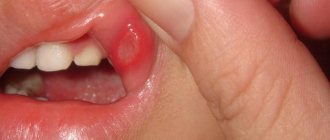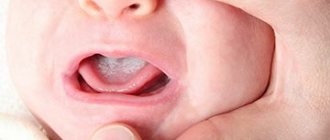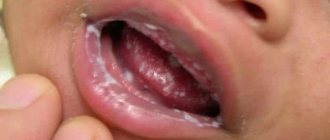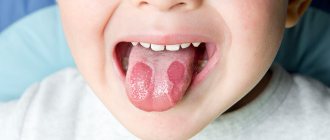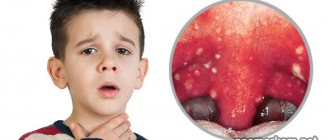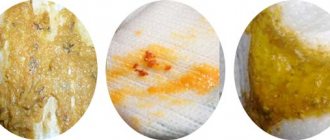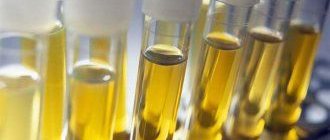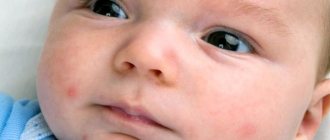White coating on the tongue of a baby - normal or pathological
In normal condition, the baby's tongue should be pink, slightly moist, smooth, with papillae evenly distributed on it. However, there are situations when a white coating appears on it, and for mothers, this is often not only alarming, but also frightening.
Indeed, in a number of cases, this symptom indicates some kind of pathological process occurring not only in the oral cavity, but also in the body. But in some situations this phenomenon can be called normal. For example:
- It can occur in breastfed babies . This phenomenon can last up to 4 months, because at this age the salivary glands are not fully developed and an insufficient amount of saliva is produced in the oral cavity. This layer is easily removed, but it can remain, especially if the baby is often put to the breast. There is no need to remove it yourself, such a procedure is unpleasant for the baby - this will only irritate the baby once again, and besides, the plaque does not pose any danger to his health.
- The same situation can arise with artificial feeding . The child sucks the formula, and it is quite natural if food residues remain on the tongue in the form of a white coating. To make sure of this, you can give the baby a little water or gently wipe the surface of the organ. Normally it should clean up. In most cases, this layer disappears on its own, because the interval between feedings is longer for artificial animals, and it has time to clear itself.
White coating on a baby's tongue
A white coating on the tongue of a baby should not be ignored, because it may indicate the presence of a number of abnormalities and negative changes in health. Parents are additionally recommended to analyze the baby’s behavior, appetite and other symptoms. White spots are the first sign of thrush. The disease is serious and requires treatment. Otherwise, the risk of worsening the situation and developing complications increases.
Child's well-being
If a white coating appears on the baby’s tongue, you should consult a doctor. The situation does not always indicate the presence of pathologies. Parents are encouraged to evaluate for additional symptoms and behavioral changes:
- There is no reason to panic if the baby is feeling great, eating and sleeping well. Weight gain plays an important role. You should only be concerned if the baby begins to refuse the breast, constantly cries and behaves capriciously.
- It is imperative to consult a doctor if your child refuses the breast or bottle. Additionally, he may also cry. The situation develops against the background of pain that he experiences when sucking the breast. As a fungus or infection develops, the body temperature rises.
The presence of white plaque is not a clear sign of the presence of pathologies in the human body. That is why it is important to carefully analyze changes in his behavior. In any case, consulting a specialist in this field will not be superfluous.
Manual cleaning of the infant's mouth
Main reasons
- A white coating on the tongue of a newborn may form after feeding. Small spots remain after milk. However, they can be easily washed off with plain water. In this case, this symptom does not indicate the presence of a disease in the baby’s body.
- A white coating on the tongue of an infant also forms in the presence of a fungal infection. Candidiasis is characterized by the formation of a large amount of cheesy, dense discharge. A negative reaction develops only in the presence of Candida fungi. In this case, heavy plaque can be additionally fixed on the cheeks, palate or gums. The disease can spread to the genital area or the umbilical cord. Fungi disrupt the natural microflora, so the child suffers from poor health. Active reproduction of microorganisms leads to the development of a number of pathologies.
Causes of fungal infection
It is necessary to find out why harmful fungal formations begin to actively grow and multiply in infants:
- improper functioning of the immune system;
- disturbances in the functioning of the gastrointestinal tract;
- hormonal imbalance;
- constant use of large quantities of antibiotics.
However, most often in a newborn, a white coating on the tongue appears in case of excessive dryness of the oral cavity. Parents should ask their pediatrician what to do in this case and ease the baby’s overall well-being. By eliminating the main causes, it is possible to completely get rid of the symptom.
Baking soda mouthwash
Features of growth and development of the fungus
Infection of a baby with harmful spores can occur in one of the following ways:
- Mushrooms tend to be transmitted to the child from the mother through the umbilical cord. Infection can also occur through amniotic fluid or the placenta.
- Almost all children become infected with candidiasis immediately after birth. The fungus penetrates his skin while moving through the birth canal. That is why a pregnant woman should be extremely attentive to her health. She is additionally recommended to give up sweets, fatty foods and starchy foods. These foods negatively affect the microflora and promote the growth of fungi.
- The risk of infection is always high in a maternity hospital if surfaces are not treated to a sterile state.
- After being discharged home, the child is exposed to a large number of bacteria and viruses against which he has not yet developed immunity. At the first stage, it is recommended to use only sterile objects and things. In this case, it will be possible to minimize the likelihood of a negative situation for the body.
Features of treatment
A white tongue does not always indicate the presence of thrush in the baby’s body. The disease can also manifest itself in a mild form. In this case, its treatment is carried out at home. At the first stage, you need to figure out why a newborn has a white coating on his cheeks or tongue:
We recommend reading: Candida solution for newborns
- If the symptom can be easily eliminated with boiled water, then these are ordinary breast milk residues. To eliminate them, it is enough to give the baby only two tablespoons of liquid to drink. Mechanical cleaning is best used last, because it will cause a lot of discomfort to the baby.
- White spots can also be found in cases of mild thrush. It can be cured at home. To do this, the oral cavity should be treated with a mixture of water and soda. Thanks to it, a unique alkaline environment will be created, which will prevent fungi from further multiplying. Additionally, all bottles and nipples must be washed in the solution. You can also clean a newborn’s tongue using a special bactericidal composition without dyes.
- White pimples most often appear in severe forms of the disease. In this case, the doctor prescribes special agents that help kill the fungi. Additionally, it is advisable to take medications to improve the functioning of the immune system. Only a doctor can choose them correctly. More recently, a composition made from borax was used to treat severe forms of thrush in children. Today it is considered inappropriate to use because it has a toxic effect on the body.
When feeding, a woman should wash her breasts thoroughly.
Candidiasis in a newborn baby must be treated at home. The full course lasts from five to seven days. Only in the case of a severe form is an increase in body temperature and a strong coating in the throat area. If treatment is not started on time, the risk of bleeding ulcers increases. Parents should carefully examine the oral cavity regularly. In this case, it will be possible to prevent the development of the disease with complications.
If candidiasis is diagnosed, parents should know how to clean the tongue at home and not harm the baby.
To do this, you need to perform the following simple manipulations:
- At the first stage, you need to prepare a solution by mixing one teaspoon of soda and a glass of boiled water.
- The parent should wash their hands thoroughly using hypoallergenic soap.
- A little bandage is wrapped around one of the fingers.
- Soak the bandage well in the resulting solution.
- Carefully massage the baby's tongue.
In order to eliminate stains on the tongue, this procedure must be repeated at least five times a day. Soda can be replaced with vitamin B12, which can be purchased in ampoules at any pharmacy. After feeding, treatment can also be done with nystatin.
If parents notice a change in the color of plaque in the mouth, then the following manipulations should not be performed:
- try to peel off white deposits;
- removal should not be carried out under the influence of great force.
When breastfeeding, it is necessary to use any traditional medicine with great caution. For example, it is often recommended to use honey, which in turn is a strong allergen. That is why you should consult your doctor before use.
The course of treatment must be prescribed by a pediatrician
Preventive actions
White spots on the tongue will not form if you follow a number of simple rules. Thanks to them, the child can receive the necessary care:
- With artificial and natural feeding options, you must wash your hands thoroughly before each meal.
- The breasts also need to be washed thoroughly. Particular attention should be paid to the nipples. Even when the child is completely healthy, there is a risk of the disease returning if the spores re-enter the body. The situation can be prevented if you regularly wash your nipples in a soda solution. However, the liquid can lead to cracks and drying out of the epidermis. The situation can be avoided if you use special creams.
- White spots on the tongue will not appear if all bottles, nipples and spoons are regularly sterilized. If necessary, the procedure is also repeated for toys and other items that are in constant contact with the baby. Plaque is quite often a consequence of the penetration of microbes and dirt into the oral cavity.
- Constant drying out negatively affects the condition of the mucous membrane. The situation weakens the body's protective functions. At this moment, microbes and bacteria begin their active action. In this case, the baby may show severe anxiety, cry and have trouble breathing through his nose. It is recommended to carefully analyze the air in the room. You may need to install an additional humidifier.
Parents and relatives are not recommended to kiss the baby on the lips. Fungi and viruses can be transmitted through contact. The baby’s body is not yet ready to resist harmful microbes and bacteria.
If a baby notices a white coating on the tongue, then you should not panic. It is necessary to seek advice if he refuses food and behaves capriciously. The pediatrician will be able to carefully analyze the situation and decide on the need for further treatment.
mladeni.ru
Causes and their symptoms
So, why might a baby develop a white coating on the tongue? In some cases, it appears as a symptom of some pathological process in the body. This situation requires immediate consultation with a doctor and further treatment. The main reasons for its appearance can be identified as follows:
- Disorder of the digestive system due to dysbiosis, constipation, feeding with an inappropriate formula, or taking antibiotics.
- Infectious diseases accompanied not only by the appearance of plaque on the tongue, but also on the mucous membranes of the oral cavity (measles, rubella, chickenpox).
- Development of stomatitis in a child.
- Taking certain medications, such as antibiotics.
- A fungal infection or oral candidiasis, known to us as oral thrush.
- The presence of diseases such as anemia, diabetes, hypovitaminosis, ARVI and even allergies.
These diseases are also accompanied by a number of other symptoms, which parents need to pay attention to and, if necessary, immediately consult a doctor.
Dysbacteriosis
This condition occurs when the acid-base environment in the intestines is disrupted, as a result of which pathogenic microflora begins to actively multiply in it. The language, however, has its own distinctive characteristics:
- The plaque covers it completely.
- It is thick, does not wash off, even if washed with water, and the mucous membrane cannot be seen through it.
If dysbiosis is not treated, the body’s condition worsens and the thickness of the plaque increases . Skin rashes, defecation problems (diarrhea or constipation), and discomfort in the abdomen are also possible, which makes the baby restless and moody.
Infectious diseases (rubella, measles, chickenpox)
- White plaque is first localized on the mucous membranes of the cheeks, palate, and only then on the tongue.
- It is not completely removed, the surface becomes blood-inflamed, and there are areas of hyperemia on the tongue.
- In addition to this symptom, the baby may have a fever and a rash on the body.
If the child is not treated, his health gradually worsens and the likelihood of severe complications increases.
Stomatitis
With stomatitis, ulcers with clear edges appear in the baby's oral cavity, which can be localized on the gums, lips, inner surface of the cheeks and even the tongue. They are painful, and this causes considerable discomfort to the baby; he may even refuse to eat. High temperatures (up to 40°) are also possible.
Thrush
This is an infection caused by fungi from the genus Candida; it is also commonly called candidiasis.
Thrush occurs quite often in infants under 3 months of age. The thing is that when a child is born, the body begins to be actively populated by various microorganisms, and pathogenic microbes come with them. And since immunity has not yet been fully formed, and the salivary gland does not produce enough saliva, infection may occur .
The main symptoms of thrush are the following:
- In appearance, the layer on the tongue resembles a curd mass.
- It can cover, completely or partially, even the mucous membranes of the cheeks, palate and gums.
- It separates painfully, and a bleeding surface forms in its place.
- Such sensations bring a lot of inconvenience to the child, he becomes capricious, restless, sleeps poorly and refuses to eat.
Why does a baby have a white coating on his tongue?
Young parents monitor the condition of their newborn baby very carefully. Indeed, during this period of life, the child is almost completely deprived of immunity: he will receive it gradually, while feeding with mother's milk. Any, even the most minor illness, at this time can turn into a serious problem.
Very often, after feeding, mothers notice a white coating on the tongue of their newborns and naturally wonder why it appeared? Since this phenomenon is very common, knowledge about this problem is important for all parents and those who are just planning to add to a young family.
Why does it appear in newborns?
The most common cause of this phenomenon that worries parents is a fungus. All adults have it, it is part of the natural microflora. But with normal immunity, a person does not encounter it. And only during illnesses that weaken the body’s protective functions, or after taking strong antibiotics that kill beneficial microflora, does the fungus grow, causing obvious symptoms caused by thrush.
The reason for the appearance of a white coating on a child’s tongue
What is plaque like in infants?
As soon as parents notice a whitish layer on their child’s tongue, they immediately begin to panic and are going to run to the doctor. There is no need to become overly concerned right away. First, it makes sense to answer a few questions:
- Is the plaque there all the time or does it appear from time to time?
- How dense is it?
- Does your baby show signs of anxiety around him?
- What color is the plaque?
If your personal observations have shown that plaque occurs with a certain frequency, it is worth analyzing whether it coincides with feedings. It is possible that this is just leftover milk or formula. This plaque is not very dense, it is easy to remove without causing discomfort to the baby. And in most cases it disappears without outside intervention.
If the plaque has a yellowish or grayish tint, home treatment should be abandoned: it is necessary for a professional to rule out the presence of infections or other diseases. The doctor himself will determine how to remove plaque from a newborn’s tongue and give recommendations to parents.
How to get rid of plaque
Causes of plaque
So, the reason why a baby has a white coating on the tongue may be:
- remains of mother's milk;
- thrush;
- mixture particles.
Most often, when parents see plaque, they think about thrush. But before making hasty conclusions, it is worth observing the baby for several days.
the appearance of a white coating on the baby's tongue
How to distinguish thrush
Plaque is not the worst thing that can happen to your child. Rather, it can be classified as a nuisance rather than a disease. Discomfort in this case is minimal: the most that can bother the baby is a slight itch. But leaving things to chance is also wrong.
Firstly, children suffering from candidal stomatitis are more restless than their healthy peers. This is especially evident during feeding. And secondly, thrush can actively develop in the body, especially taking into account weakened immunity.
A simple and accessible test will help determine whether the white coating on the tongue of a newborn baby is actually thrush. Removing milk residues requires almost no effort, while traces of candidiasis are tightly connected to the mucous membrane and are more difficult to remove. If this is still possible, small marks with a more intense color than the surrounding tissues often appear on the surface of the tongue, and in some cases, bleeding spots.
Why does feeding cause plaque?
It is normal and even natural for food debris to linger on the surface of a baby’s tongue. After half an hour, there is usually no trace left of such a deposit: saliva gradually washes away the milk. Traces of it are usually visible only on the tongue: the gums and cheeks are not covered in this case with even a minimal coating.
Why does a white coating appear on the tongue?
The child does not experience discomfort from this, his behavior remains the same, without signs of anxiety. The layer of plaque is very thin: the pink tongue clearly shows through it. It is clear that such a white coating on the tongue of an infant is not dangerous, but it can become an excellent habitat for the fungus that causes thrush. The best prevention: take a sip of water immediately after feeding.
Thrush: what is the cause of the disease
Thrush of newborns is stomatitis caused by overgrowth of fungi of the genus Candida. They constantly live on the mucous membranes of all adults, and this is considered the norm. A healthy immune system prevents them from developing uncontrollably, causing serious damage.
A newborn is very poorly protected in this regard: his immune system practically does not work, and yeast-like fungi feel like complete masters on the baby’s oral mucosa. A baby can become infected with a fungus in different ways:
- pacifiers and toys;
- maternal breast;
- air;
- infection during childbirth.
The popular myth that the mother who does not follow hygiene rules is to blame for the presence of thrush in a child is being debunked by doctors. If she can infect her child, then only during natural childbirth or immediately after its completion: candida simply transfers from the mucous membrane of an adult to the mucous membrane of a baby.
What to do if a coating appears on the tongue
Plaque during artificial feeding
Using formulas may also cause a white coating on the tongue of a month-old baby. This phenomenon is completely safe: traces of food are gradually removed with the help of saliva. To make sure that the reason for this phenomenon lies in nutrition, conduct a small experiment. Hold the prepared mixture in your mouth for a while, and then evaluate the condition of your own oral cavity.
You can distinguish a safe plaque from a thrush by these signs:
- the layer covers not only the tongue, but also the gums and palate;
- it is easily removed with water;
- the whitish layer is translucent and is distributed evenly over the surface of the tongue.
In this case, there is no point in getting rid of it: gradually everything will return to normal on its own.
Signs of thrush
- plaque covers all mucous membranes in the mouth: cheeks, gums, tongue and palate;
- outwardly it looks like small white spots; when neglected, they turn into a uniform cheesy layer;
- attempts to remove plaque with cotton wool fail;
- redness is often detected under the layer;
- the child shows anxiety and refuses to eat.
Factors that provoke thrush
When answering the question of why a newborn has a white coating on the tongue, you need to take into account the influence of the following factors on the development of candidiasis:
- Frequent regurgitation.
- Fluid deficiency.
- Hot and dry indoor air.
By increasing the humidity in the room and giving the child enough water, you can avoid drying out the mucous membranes. This will help them perform their functions normally and limit the growth of the fungus.
Causes of plaque on the tongue
Treatment and prevention
After you have found out why the baby has a white coating on the tongue, you need to begin treating the disease. You can do this yourself in two ways:
- Soda solution. Dissolve 15-20 grams in a glass of water and wipe the affected mucous membrane with a cotton pad dipped in it. The maximum frequency of procedures is no more than 5 times a day.
- Honey. It is diluted with water in a ratio of 1:2 and applied to the lesions of thrush. But this method is quite risky: honey provokes severe allergies.
What to do if you find a white coating on your baby’s tongue?
If simple recipes do not help, you should consult a specialist. It is still difficult to diagnose the disease on your own: a white coating on a baby’s tongue, a photo and description of which can be found on any medical website, is not always an accurate sign of thrush.
Before visiting the pediatrician, follow all hygiene rules: regularly boil nipples, sterilize milk bottles or formula. Don’t forget about this after recovery: this will help avoid re-activation of yeast-like fungi. It would be advisable for mothers to treat their breasts in the nipple area with a soda solution throughout the entire period of lactation.
Correct and timely treatment will help completely solve the problem of thrush and relieve the baby from discomfort.
the appearance of a white coating on the baby's tongue The reason for the appearance of a white coating on the child's tongue Why does a white coating appear on the tongue What to do if you find a white coating on the baby's tongue? Causes of plaque on the tongue How to get rid of plaque What to do if plaque appears on the tongue
vashyzuby.ru
Diagnostics
Diagnosing this condition in an infant is quite simple - you need to carefully examine the baby’s oral cavity and analyze the quality of plaque . If there is one, you can try wiping your tongue with a cotton swab dipped in water.
If there is no disease, you can easily remove everything, and it will become smooth and pink again. But if it is not removed or bloody spots appear in its place, an additional examination may be prescribed in order to determine the cause of this condition. For example, stool analysis, clinical blood and urine analysis, white plaque analysis, etc.
Treatment
Firstly, you need to understand that white plaque in a baby is not an independent disease, but just one of the possible symptoms, so you first need to determine the true cause of its appearance, and only then begin treatment. So if a child has such an alarming symptom, it is necessary to contact a doctor and consult about this.
The following are used as general measures:
- Treatment of the oral cavity with painkillers so that the child can eat.
- The use of antiseptic and anti-inflammatory agents, including various solutions and decoctions of plants.
- Use of antifungal medications (in case of thrush).
If the cause of such a symptom is dysbacteriosis, the baby may be prescribed a probiotic to normalize the microflora; in the case of infectious diseases, antimicrobial and antiviral drugs, as well as drugs that increase the body’s protective functions.
White coating on the tongue of a newborn baby: is it dangerous and how to remove it?
Close attention to the health of the newborn child is typical for all mothers. In many ways, this concern is justified - the immunity of babies is weaker than that of older children, diagnosis is more difficult, and complications are more common. Many people know that the appearance of a person’s tongue can “tell” about some of his diseases. A change in the color of a baby's tongue causes concern, especially when the long-awaited baby is the first child in the family. But experienced parents already know that a white coating on the tongue of a baby in most cases is either not a symptom of the disease at all, or is easily cured.
Reasons for the appearance of white plaque on the tongue
Normally, the tongue of a healthy baby is evenly colored pink, velvety to the touch, the oral mucosa is without light or red spots, ulcers, the gums are light pink and dense. A white coating on the tongue in the morning is normal for both children and adults; it gradually disappears during the day. If it remains all day, thickens and spreads to the palate, inner surface of the cheeks and lips, you need to consult a doctor for diagnosis and treatment.
Traces of breast milk or artificial formula and remnants of undigested food that entered the newborn’s mouth during regurgitation are the most common causes of plaque in a newborn baby; they are absolutely natural and do not affect his health.
Reasons that require treatment why a baby may have a white tongue:
- thrush - infection of the mucous membranes by a fungus;
- colds, especially those accompanied by a bacterial infection, often stain the tongue: with bronchitis, the tip of the tongue becomes white, pharyngitis leads to reddening of the papillae and the appearance of a thick white coating, with tonsillitis it forms on the root of the tongue and tonsils;
- scarlet fever turns the tongue white-yellow with red spots;
- diphtheria gives a white and gray coating, spreading to the tonsils;
- for intestinal problems, the film is brownish and lasts all day.
In all cases except thrush, coating on the tongue is not the decisive symptom when making a diagnosis; there are more characteristic manifestations - fever in infectious diseases, frequent loose stools in gastrointestinal diseases.
Relationship between feeding and plaque
Before looking for pathology in a baby, it is worth remembering that all the food he consumes is white. In babies under 4 months of age, the salivary glands are underdeveloped, the tongue's functioning is imperfect, and the oral cavity is poorly cleaned of food debris. The coating formed from food is uniform, slightly transparent, taste buds are visible through it, and does not cause discomfort. Such a white coating on the tongue of a newborn does not require treatment.
Breast-feeding
During breastfeeding, plaque occurs more often than during artificial feeding. Its difference is that it affects exclusively the tongue, the rest of the oral cavity remains clean. It usually disappears half an hour after eating, but in children who frequently suckle it can persist throughout the day.
If the white coating is natural, it can be easily removed with a cotton swab or bandage, the surface underneath is pink, without redness. There is no need to get rid of such plaque, since it does not harm the child in any way. Moreover, the desire to clear the tongue of the white film can lead to damage to the mucous membrane and its further infection.
Artificial feeding
When feeding a child with infant formula, white plaque may also form in the mouth. Due to the fact that bottle-fed babies feed by the hour, its intensity is less and it usually disappears by the next feeding.
The coating from the mixture can cover not only the tongue, but also other places in the mouth, most often the inside of the lips. Not all mixtures leave a white coating. To find out whether the mixture consumed by a baby can cause a colored tongue, you can do a test: put it in your mouth, hold it for a few minutes, and then examine the tongue.
In a baby, a white coating due to thrush occurs more often when he is bottle-fed, since the sugar in formula promotes the development of fungi. To find out whether the film on the tongue is due to the mixture or is it the work of fungi, you need to clean part of it and examine the mucous membrane. If it hasn't changed color, there's nothing to worry about.
Thrush
Thrush in infants is the common name for oral candidiasis; it is a colony of Candida fungi that has grown on the mucous membranes of the mouth. This name fully reflects the clinical picture of the disease; the surface of the tongue and mouth is covered with a white coating, similar to curdled milk.
Plaque can spread throughout the entire mouth
A mild form of candidiasis consists of small cheesy spots on the tongue and mucous membranes of the cheeks; it does not cause discomfort and there is no bad breath. Subsequently, the mucous membrane becomes red, itching appears, the newborn begins to eat worse and becomes uneasy at the breast. If you try to remove the film, scarlet spots with bleeding spots remain underneath. If left untreated, fungi can fill the entire oral cavity and pharynx; white plaque binds closely to the mucous membrane and is difficult to clean. Thrush in severe form can spread to the mother’s breasts during natural feeding, the woman’s genitals and the baby.
Fungi that cause thrush are part of the normal microflora of the mucous membranes. Normally, their reproduction is controlled by other microorganisms and the human immune system.
The likelihood of disturbing this balance is higher in the following cases:
- The baby was born premature, with underdeveloped physiology.
- The child is completely bottle-fed and does not receive lactoferrin from breast milk, which inhibits the growth of fungi.
- He was found to have metabolic disorders, anemia, and vitamin deficiency.
Thrush is also possible after treatment with antibiotics, which suppress the activity of some microorganisms but do not affect fungi. Family members or medical staff can also infect an infant. Candidiasis brought from hospitals can be more dangerous than ordinary thrush. In hospital settings, infection with fungi that are resistant to disinfectants and antifungals is possible.
How to remove white plaque from a baby's tongue
Mild thrush can be successfully treated at home using simple remedies that do not harm the child. Significant damage to the mucous membrane by a white coating, which prevents proper nutrition, requires a mandatory visit to a pediatrician and treatment under his supervision.
Both official and folk remedies are effective against thrush. Treatment time varies from 3 to 14 days.
Medicines
Most often, to remove white plaque in newborns, pediatricians prescribe:
- The drug Candida. It is a 1% solution of clotrimazole, an effective antifungal agent. Improvement with its use occurs already on the 3rd day, and after a week the thrush completely disappears. When applied topically, this drug has no contraindications and is easily tolerated.
- Self-made nystatin solution. The tablets are crushed and diluted in warm boiled water. For 5 ml, half a tablet of nystatin is required (250 thousand units).
- With extensive plaque, it is possible to prescribe fluconazole orally.
- Severe forms of thrush require hospital treatment and intravenous administration of antifungal agents.
It is more convenient to treat the oral cavity with solutions using a bandage wrapped around a finger. It should be as gentle as possible; white deposits that cannot be cleaned off immediately should not be touched. The mouth is treated with medications 4-6 times per day.
Traditional methods
Of the folk remedies for getting rid of white plaque in infants, the most effective is baking soda. It creates an alkaline environment in the child’s mouth, which has a detrimental effect on fungi. The procedure requires a 2% solution (about a teaspoon in a glass of water). Treatment with soda must be carried out within 14 days. If the plaque has completely disappeared earlier, treatment is not stopped.
There are often recommendations to lubricate the child’s mouth with diluted honey. Despite the fact that honey can fight thrush, it is better not to use this method for newborns due to the high allergenicity of bee products.
Prevention
To prevent the formation of plaque, it is necessary to monitor the cleanliness of bottles, pacifiers, teethers, and periodically sterilize them. Adults who come into contact with infants should be treated for candidiasis in a timely manner. If a baby is prescribed an antibiotic, the condition of his mouth should be monitored especially carefully and treatment should begin as soon as plaque appears.
Children with birth injuries, premature babies, born to mothers with chronic candidiasis should be examined in the first week of life.
babynolog.ru
Prevention
- Make sure that the room in which the newborn is most often found is well ventilated: if the room is too hot, the oral mucosa will dry out, and this already provokes the appearance of this condition.
- If it is not possible to provide the necessary humidity, periodically give the baby a little water to moisten the oral mucosa. It is also advisable to give a couple of sips of water after each feeding to rinse the mouth.
It is also important to organize the necessary sanitary conditions: wash toys, especially if the baby actively puts them in his mouth, wash bottles and pacifiers well. Monitor breast hygiene if the baby is breastfed.
- The condition of the tongue directly depends on the condition of the whole organism, so it is important to periodically check the functioning of the internal organs to exclude possible diseases.
Helpful information
There are a huge number of different diseases that affect infants. In the first year of life, some develop rickets, others have to deal with a short frenulum, or such an unpleasant condition as an umbilical hernia. Many newborns develop allergies, the appearance of which can be triggered by a wide variety of allergens. This is the reality in which we live, and the most important thing that every parent can do is to learn in detail about these conditions and do everything to prevent them, so we recommend that you familiarize yourself with this information. This is very easy to do - just follow the links provided.
Has your family ever faced a similar problem? What measures did you take and what helped get rid of the white coating on your baby’s tongue? Share your stories, tips that can help others, and don’t forget to leave your feedback on the article you read in the comments.
